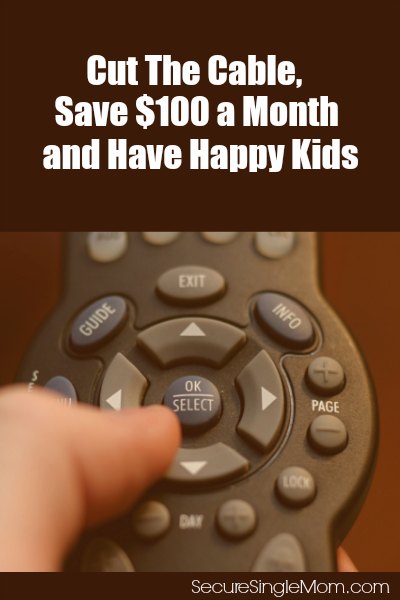Well, I did it again.
Throughout my life there have been multiple periods during which I decided to go either cable free or completely television free. As I recall, each occurrence of tube-free existence began in about the same way.
Look at this bill!
They’ve raised prices again!
Can you believe 500 channels and not a darn thing to watch!
Each time I’d cancel cable and find other things to do.
I’d marvel at how wonderful it was to spend so much time with friends again (mooching their TV), read books, get more exercise, yada, yada.
But eventually I’d be lured back.
Maybe it was a slick salesman at the door with a “heck of a deal”. Or a spouse who just had to have CNN to keep up with the presidential election.
Most recently as hubby and I were getting divorced, money was tight. Without hesitation, cable TV was the first thing to go. But this time around I had something to consider which I didn’t have in the past. More specifically, how much did I want to listen to the kids squeal?
If truth be told, even though I knew we could go completely television free – and, despite their convictions otherwise, they would survive – because of the divorce I felt their lives were already changing too much. I wanted to do what I could to keep as much else about our lives familiar and comfortable, so I began investigating options.
Perhaps there were alternatives and we didn’t need to choose either all or nothing.
1. Our First Quick Streaming Fix
The first decision I made was to create a Netflix account. It’s fast, easy and at $8.95 a month, very reasonable.
NOTE: Netflix, known as a ‘streaming service’, is only one of many which are available. Most recognizable services are Netflix, Amazon Prime, and Hulu. See another post of mine for a side-by-side comparison of these and other streaming services..
Setup was as easy as downloading an app, and it didn’t take the kids long to learn their way around and discover all their old favorites. With Netflix and wireless internet each kid suddenly had private viewing at their fingertips. Using a computer, their iPod, or a Kindle Fire tablet they could lay in bed, or anywhere else wireless could take them, and have access to all the movies and TV shows they could imagine. There are never any commercials (how great is that) and you can pause, rewind, fast-forward and watch any movie or episode as often as you like.
Honestly, the kiddos seemed pretty happy . . . but this mama wasn’t.
Because Netflix was available on every handheld device, we no longer hung out in the living room watching TV together.
I missed family time!
There were options for receiving Netflix on our living room TV, but we had problems with each. Our ten-year-old TV is not ‘smart’ enough on it’s own to work, getting movies through the Wii gaming system was awkward and inconvenient, and hooking up to the TV through a laptop through the wireless . . . oh my. Nothing we had available was convenient enough to bother with, and so we lived with what we had.
2. Our Introduction to Fire TV
Recently, (thanks to an Amazon Black Friday sale this past Christmas season) we have started using Fire TV, and with our new acquisition watching movies and shows on the big screen have been made pleasurable once again.
NOTE: Known as a ‘streaming media player’, the Fire Stick is just one of many options available. For a more complete comparison of the options available, see this article.
The option I chose, the Fire Stick, is a tiny device called a ‘dongle’, and it’s similar in size and form to a USB thumb drive.
Installation couldn’t have been easier. The dongle plugs in to the TV’s HDMI port on the back of the TV. (Most newer TVs have this. Our older TV did not, but we are using it on a larger-style computer monitor and it works great.) An electric connection for power is also required. After that it’s as simple as following the instruction sheet which came in the box and instructions on the screen once it powered up.
We have remote again and it feels like a real TV.
We have easy on-screen access to several different streaming services. Some require a paid subscription (Netflix, Hulu, Amazon Prime) but others (YouTube) do not.
For the most part, the kids still prefer watching from their handheld devices in the seclusion of their bedrooms. (Really! What did I expect of teens?) But my 88-year-old mother who lives with me is thrilled! On YouTube, we’ve found hundreds of full length video recordings – some from as far back as 1985 – of her favorite football team playing ball. Honestly, I don’t know if Mom would climb out of bed some days if it weren’t for those football games. 🙂
3. Option for local
The final domain to conquer in our quest to completely replace cable TV was finding an option for local news. Now, as well as in the past, going without traditional television is most notably missed when I want to watch live news casts, especially when something particularly newsworthy is happening.
A quick review of options led me to the Mohu Leaf Indoor HDTV Antenna. The reviews online are good and the price is right. Because I live in a large metropolitan area and have stations quite near to me, I chose the ‘Metro’ version of this indoor antenna. If you live in a more remote area or have obstructions which prevent a clear line of sight to towers one of their other options may be better for you. The government station reception map at http://dtv.gov/maps is a handy tool and will give you an idea of how many stations are in your area as well as how strong of a signal you can expect at your location.
Have you cut the cable? Comment below and let me know what options you found to work best and why.






